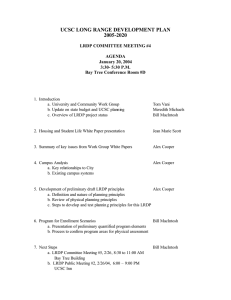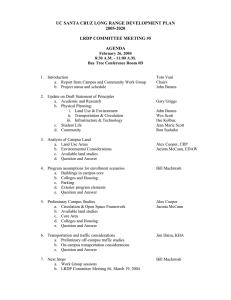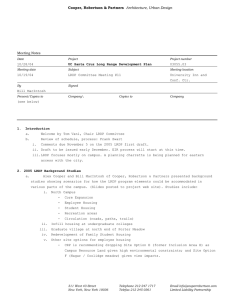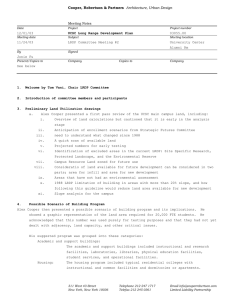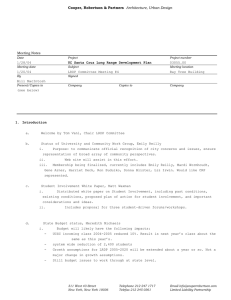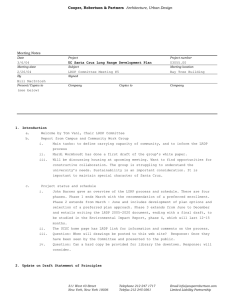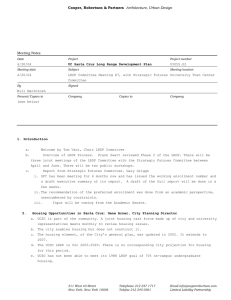Cooper, Robertson & Partners
advertisement
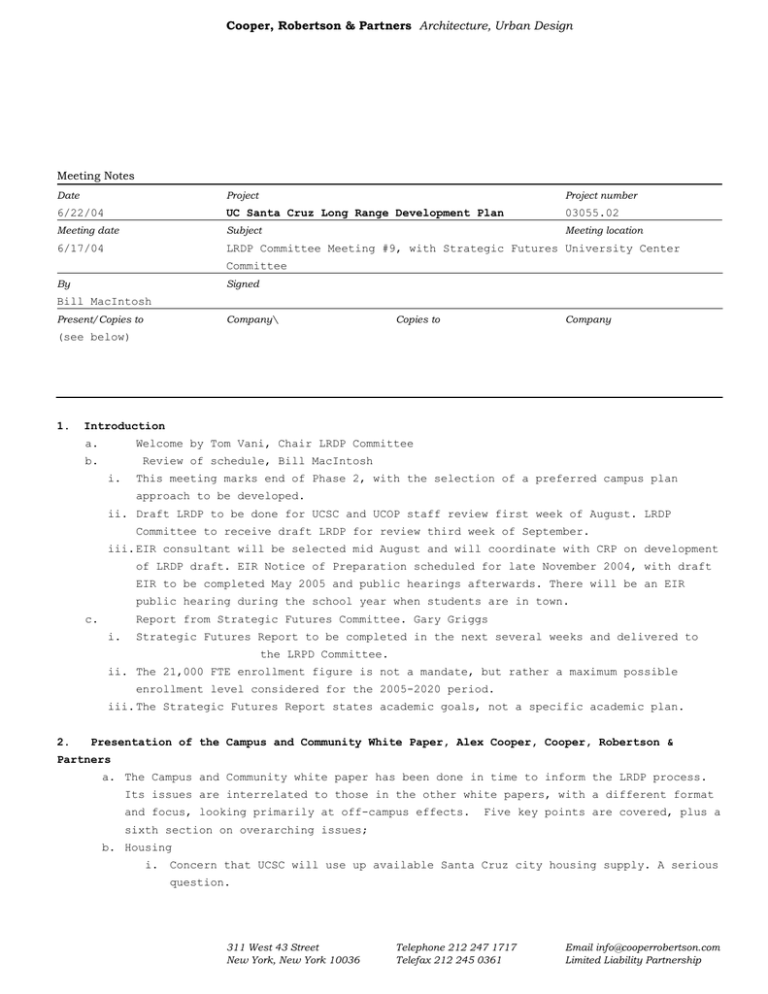
Cooper, Robertson & Partners Architecture, Urban Design Meeting Notes Date Project Project number 6/22/04 UC Santa Cruz Long Range Development Plan 03055.02 Meeting date Subject Meeting location 6/17/04 LRDP Committee Meeting #9, with Strategic Futures University Center Committee By Signed Bill MacIntosh Present/Copies to Company\ Copies to Company (see below) 1. Introduction a. Welcome by Tom Vani, Chair LRDP Committee b. Review of schedule, Bill MacIntosh i. This meeting marks end of Phase 2, with the selection of a preferred campus plan approach to be developed. ii. Draft LRDP to be done for UCSC and UCOP staff review first week of August. LRDP Committee to receive draft LRDP for review third week of September. iii. EIR consultant will be selected mid August and will coordinate with CRP on development of LRDP draft. EIR Notice of Preparation scheduled for late November 2004, with draft EIR to be completed May 2005 and public hearings afterwards. There will be an EIR public hearing during the school year when students are in town. c. Report from Strategic Futures Committee. Gary Griggs i. Strategic Futures Report to be completed in the next several weeks and delivered to the LRPD Committee. ii. The 21,000 FTE enrollment figure is not a mandate, but rather a maximum possible enrollment level considered for the 2005-2020 period. iii. The Strategic Futures Report states academic goals, not a specific academic plan. 2. Presentation of the Campus and Community White Paper, Alex Cooper, Cooper, Robertson & Partners a. The Campus and Community white paper has been done in time to inform the LRDP process. Its issues are interrelated to those in the other white papers, with a different format and focus, looking primarily at off-campus effects. Five key points are covered, plus a sixth section on overarching issues; b. Housing i. Concern that UCSC will use up available Santa Cruz city housing supply. A serious question. 311 West 43 Street New York, New York 10036 Telephone 212 247 1717 Telefax 212 245 0361 Email info@cooperrobertson.com Limited Liability Partnership Cooper, Robertson & Partners Architecture, Urban Design Meeting Notes ii. iii. Urge to preserve economic and social diversity and character of the community. There are opportunities for UCSC/SC partnership to pursue housing strategies offcampus. iv. The question of the feasibility of state subsidies was raised relative to affordability. c. Transportation and Traffic i. ii. iii. This is a big issue, especially on access roads leading to the university. Intersections off-campus are now being measured. Off-campus conditions are affected by on-campus decisions and will be considered when developing the campus plan and measures to improve traffic. iv. The Master Transportation Study is a good document that could help very much if implemented. d. Infrastructure i. Focus in the paper is almost exclusively on water. Concern about drought and cost of new supply. ii. UCSC has used various strategies to reduce water. Arup has outlined strategies to continue efficient use of water. iii. Wells on campus have been suggested. UCSC has done exploratory wells already. e. Economics i. This section describes the city’s 7 revenue sources and impacts from the university’s tax-exempt status. ii. iii. UCSC is both a consumer of services and a provider of indirect revenue. Recognition of the need for new economy type jobs. Opportunities for UCSC/SC partnership to provide these. iv. White paper raises question of possible state funds to replace revenue lost to tax-exempt status. f. Recreation and Open Space i. ii. City has little new land, money to buy, or money to run recreation facilities. UCSC LRDP to locate more recreation functions on campus. g. Overarching Issues i. These include lack of city and state funds and the perceived deterioration of the quality of life in Santa Cruz. ii. iii. UCSC and SC must partner to address these issues Comprehensive analysis and data sharing are an important first step to understanding growth effects. h. What will be done with the white paper? CRP is absorbing it, and with UCSC will provide responses to the 51 recommendations. Responses can be sorted: those things already done; ongoing studies; items best handled during the EIR; explicit funding recommendations i. Emily Reilly thanked Alex and noted that this is a very different time than the last LRDP 15 years ago. She has heard sincere appreciation from the community for having this group. They have had one meeting with the community already and another is planned at LRDP Committee Meeting #9 CRP No. 03055.02 Page 2 of 7 Cooper, Robertson & Partners Architecture, Urban Design Meeting Notes the end of June. The work group itself met 10 times. The stresses noted in the white paper are real. This is a good beginning at addressing them. Need a relationship between the city and university that is sustainable through good and bad times. Importance of recognizing that what is bad for the city is bad for the university. Thanks to Galen Jarvinen for his work on the white paper. j. Mardi Wormhoudt noted that the meetings were hard work and there was not consensus on every issue. Need for innovative and creative thinking to solve problems. Recognition that many of the issues will be addressed in the EIR phase. Real issue is whether the university realizes how serious these issues are for the city. 1988 LRDP called for some mitigation measures that were not realized since they were not practical. What are assurances to the community that these mitigation measures will be implemented? k. Emily Reilly read a letter from west side residents who state that the white paper does not adequately address traffic and parking issues in their neighborhood. They asked that the paper be revised accordingly. l. Ron Suduiko noted that the process was not easy. The problems were often easier to identify rather than solve. Resolve will be needed to persevere to find solutions. Concurs that what is good for the community is good for the university. Thanks to Emily for co-chairing. Recognition that the UCSC leadership is starting to demonstrate a willingness to work with the community, as shown in the chancellor’s recent proposals. 2. Land Use Concept Plan Options, Bill MacIntosh, Cooper, Robertson & Partners a. CRP gave an overview of refinements to Option B and D’ and proposed a blended preferred option for consideration. b. North campus conditions were shown in 3D, including Campus Natural Reserve and environmental high constraint areas. Options for north campus development that simply avoided constraints were considered too fragmented and undesirable by Land Use and Environment work group. Preference is for a plan that integrates natural and built environment better and more rationally. c. Environmental constraints are still coming into focus. Rather than prescribing exact locations for future development with incomplete information, the LRDP will move forward with a more performance-based approach that seeks to optimize development flexibility and minimize impacts to the CNR and natural systems in the north campus. Different scenarios for core expansion were shown. d. Extent of needed student apartment infill projects was shown. More in Option D’ (compact approach). e. College 11 and 12 site in Option D is relatively constrained. Using College 9 and 10 beds and net area, and 106 beds per acre, the site could accommodate 1,275 beds or more if topography yields greater lot area. f. Core studies showed how building footprints can be reduced with taller buildings (4-5 story range where surrounded by trees) and with some core expansion (Option B). Less footprint appears more desirable to conserve character. LRDP Committee Meeting #9 CRP No. 03055.02 Page 3 of 7 Cooper, Robertson & Partners Architecture, Urban Design Meeting Notes g. Finding an optimum location for employee housing is a challenge. LUE work group proposed considering base of east meadow, with realignments of Coolidge and Hagar and careful consideration of views and arrival experience. CRP to study. h. The proposed preferred plan blends north loop road and core expansion with college locations of Option D’. College 11 and 12 location at camper park site (Option D) is considerably easier to access than above Crown Merrill Apartments (Option B). This plan has the flexibility to accommodate growth to 21,000 without major change to the campus character. 3. Open Space Considerations, Jacinta McCann, EDAW a. In Option B visual impacts of north campus development on the UCon trail could be mitigated by building setbacks from trail, screening or some rerouting of the trail. b. An overview of north campus habitat types and teaching areas was presented. A rich variety of teaching and research areas near the core is desirable. c. An at-grade study for McLaughlin was proposed to unite engineering and science hill without relying on an expensive depressed roadway that may not be feasible. d. The slope from engineering to the north loop road may be in the range of 18%. Core expansion will be located for the best pedestrian access. e. Studies were done of existing building height and densities and for how the pedestrian “tartan grid” would change in Option D’ with the most core development. Significant natural areas would remain in the core between developed clusters. 4. Options for Campus circulation and parking, Jim Daisa, KHA a. Jim Daisa presented elements of a comprehensive campus transportation system for b. Common road elements to both options include the Meyer Drive Extension; Hagar / Options B and D’. Coolidge connection; Empire Grade connection; and restricted access on a portion of Hagar c. Option B is characterized by the north loop road. d. Both options include parking structures at the east remote (1,000-2,000 additional spaces), performing arts (+600), and north of Stevenson (+1,000). e. f. Both options include pedestrian and bike enhancements to Hagar and McLaughlin. Variations for the Meyer Drive extension were discussed. Some students favor no extension to prevent cars from degrading the character of the arts area and great meadow. Not extending Meyer is not recommended at an enrollment of 21,000 since the current circulation system will essentially have to handle this increase, and it is already stretched. g. A Meyer Drive extension that includes transit and pedestrian only bridge between arts and Hahn peninsula is preferred since this will not introduce car volume in the arts, will improve shuttle service and will greatly reduce vehicle traffic at Quarry Plaza. LRDP Committee Meeting #9 CRP No. 03055.02 Page 4 of 7 Cooper, Robertson & Partners Architecture, Urban Design Meeting Notes h. At-grade enhancements for McLaughlin are recommended based on cost effectiveness. An underpass between Engineering and Sciences will still see multiple pedestrian crossing conflicts with vehicles in other part of the road that need to be addressed. 5. Infrastructure and Utility Assessment, a. Aidan Hughes, Arup Water infrastructure is similar in scope for Option B (Core expansion) and Option D’ (compact development) since upgrading of lines in the core in D’ offsets cost of new lines for north campus development in B. b. c. Option D’ has less infrastructure costs than Option B for gas and electricity. Utility availability for potential employee housing locations was reviewed. Sites A (inclusion area A) and F (base of east meadow) have utility service nearby. Site B, opposite Empire Grade requires extension of gas and sewer lines. Site C (far north campus) requires extension of water, sewer, gas and electric and the construction of a water tank. Site E (inclusion area E) is too small for viable development. 6. Comparative Value Assessment, Mark Kelly and Fernando Espana, Mack5 a. Mack5 reviewed land use options B and D’ to developed a financial model for a compare value assessment. b. The model accounted for both quantitative and some qualitative factors with the goal of being as objective as possible. Mack5 interviewed multiple stakeholders and attended planning work sessions to understand the LRDP issues and context. c. Mack5 first established baseline conditions, including the same program (at 100% CPEC) for each option and then applied adjustment factors based on level of difficulty for implementing each option. d. Option B was considered to provide more economies of scale, more opportunity for efficient infill, less campus disruption and more efficient construction conditions. Option D’ has less development footprint overall and closer adjacencies, but less efficient construction and infill conditions. e. Mack5 finds that Option B would be 10% less costly to realize than Option D’. f. Infrastructure and transportation represents a fraction of the overall development cost g. Question: At what point with a decrease in building program does Option B become more and is perhaps around 12% of the cost of the buildings in the LRDP. expensive? Response: When the building program drops to approximately 50-60 % of the full LRDP program (100% CPEC) then this difference begins to equalize. h. Question: What is meant by “efficiency”. Response: Includes geological conditions, congestion, construction staging, and ability to flexibly laying out the building internally in the most efficient way. i. Question: Did Mack5 take increased commute time into account for greater distances between core areas in Option B? j. Response: No. This was not part of the assessment. Question: What is meant by relational value? Response: relative cost. LRDP Committee Meeting #9 CRP No. 03055.02 Page 5 of 7 Cooper, Robertson & Partners Architecture, Urban Design Meeting Notes 7. Breakout Session, findings by table leader a. Bill MacIntosh table - Consensus in favor of the proposed preferred plan - Support for Meyer Drive access to Hahn peninsula for parking, but not through access for cars that would impact arts area. - Student concern on development of Porter Meadow - Concern that core expansion areas are not isolated. Needs to be a compelling, strategic reason to make the leap up there and develop. - Similar concern for fragmentation of operations. Bill notes core expansion functions to be suitable for this location, or else will be done as in-fill for adjacency. - Support for College 11 and 12 location - Plan gives for future beyond 2020, with completion of transportation system - Support for corp yard relocation - How to make apartments in the north campus into a community. Consider as a new college? - Student preference to locate as much new housing as possible near respective college as infill to promote identification with the college. b. Jacinta McCann table - Unanimous support for proposed preferred plan - Recognition of need to do infrastructure the whole way, to achieve north loop road - Perhaps consider tighter north loop road alignment - Locate new core expansion to north to improve walking distances from those shown - Co-location of some new housing and recreation is good. - Moderate in-fill housing is good - Consider athletic field expansion on current construction staging site and east of event center site to avoid east meadow - Employee housing site “B” is not preferred. Site “F” should be studied more, but must keep the integrity of the vista c. Jonie Fu table - General agreement that the proposed preferred plan is the right direction - Grouping some new housing and athletics is good. - Employee housing preferred at “B” location. Also consider locating east of Empire Grade (inclusion Area C). - Proximity of expansion to core also needs to be assigned some value. Adjacency is important. d. Aidan Hughes table - General support for the proposed preferred plan. - Performing Arts garage should be on Heller or accessed from Heller. - Strong support for 2 bridge Meyer Drive. - Make sure there is adequate east-west pedestrian connection above McLaughlin. LRDP Committee Meeting #9 CRP No. 03055.02 Page 6 of 7 Cooper, Robertson & Partners Architecture, Urban Design - Meeting Notes Little support for any employee housing location. B should be studied but could be politically difficult. Like 11/12 colleges proximity to core. Study needed for Trailer Park - is it an appropriate land use as shown? Consideration needed of the flexibility of this plan to allow future Eastern access. What is the expended core within the loop road? It should have designation/design or use allocated and demonstrate connections (warped pedestrian grid). Check north loop road alignment. Can it be closer to core? Consider more integration of uses north of loop road not just finding space for individual elements OPERS fields Meadow. Isolated. Also, try to put fields elsewhere to maintain "green belt". Cave Gulch road and moving corp yard critical. Some resistance (2 out of 6) to 5 or 6 story buildings e. Jim Daisa table - General support for proposed preferred plan - Employee housing at meadow intriguing (location “F”). OK to reflect urbanization at campus gateway. - Good for grad students to be near the core, but concern they may be too close to undergrads. - Concern about environmental studies not done yet, but appreciation for a sensitive approach to north campus natural areas. - Support for Meyer Drive extension being full vehicle access and restricting a section of Hagar. - Concern that a dispersed approach to development will be more costly - Would like to see cost of preferred approach developed - Need a survey of undergrad and grad students for housing preferences f. Marcia Tobin table - Consensus on proposed preferred plan, “BD”. - It provides flexibility for development and for the future. - The connection to Empire Grade is good for access and flexibility - Preference for employee housing location is “B” (west of Empire Grade) then “F” (base of east meadow) - Hard to tell impact on north campus environment given preliminary nature of plan - Matt Waxman prefers college locations from Option B (Grad at Camper Park, 11 and 12 above Crown Merrill) to minimize development of Porter Meadow. 8. Session Summary and next steps a. There is consensus on the proposed preferred plan as a recommendation from the LRDP Committee. LRDP Committee Meeting #9 CRP No. 03055.02 Page 7 of 7 Cooper, Robertson & Partners Architecture, Urban Design Meeting Notes b. This plan will be developed over the summer in the draft LRDP report, to go to UCSC and UCOP staff for review in early August c. The LRDP Committee will receive a draft for review the third week of September d. Items noted for more study will be investigated further in Phase 3. LRDP Committee Meeting #9 CRP No. 03055.02 Page 8 of 7 Cooper, Robertson & Partners Architecture, Urban Design Meeting Notes Committee members present: Members Not Present Tom Vani, Chair Michael Bade Gene Arner Mike Bolte Tamara Belknap Wlad Godrich Christina Valentino Gary Glatzmaier Donna Blitzer Bill Hyder Harriet Deck Gail Heit Peggy Delaney Robert Miller Pamela Edwards David Rinehart Amy Everitt Leslie Sunell Maggie Fusari Karen Holl Gary Griggs Jack Zimmermann Francisco Hernandez Steve Kang Frank Zwart Fran Owens Liz Irwin Jean Marie Scott Carl Walsh Mardi Wormhoudt Staff present: Matt Waxman Dan Wood Ilse Kolbus Elise Levinson Larry Merkley John Barnes Meredith Michaels Teresa Buika Emily Reilly Dean Fitch James Sheldon Galen Jarvinen Ron Suduiko Ken Thomas Alisa Klaus Kathleen Dettman SFC Members Alison Galloway Consultants present: Michael Hutchinson Mark Kelley Richard Huey Fernando Espana Jennifer Gonzales Aidan Hughes Alex Cooper Jim Daisa Bill MacIntosh Jonie Fu Jacinta McCann Megan Walker LRDP Committee Meeting #9 CRP No. 03055.02 Page 9 of 7 Cooper, Robertson & Partners Architecture, Urban Design Meeting Notes LRDP Committee Meeting #9 CRP No. 03055.02 Page 10 of 7
